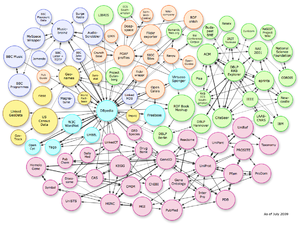A recurring topic in semantic web circles involves the amount of linked data proliferating across the web and how major players are using the data.
To sum up, there are a variety of linked data formats (thin to fat) covering various subject areas in use by numerous websites/analysis tools. Most recently, RDFa (a thin format that’s been called CSS for semantics) has been gaining popularity. Google supports RDFa, maintains RDFa guidelines for publishers, and exposes rich data snippets derived from RDFa via search and other apps. By some reports, adding RDFa tags can boost inbound traffic as much as 30% (see this article on Best Buy).
There are still lots of unsettled areas — agreeing on uniform vocabularies for topics (think cross-browser CSS tag support), navigating the confusing array of namespaces housing these vocabularies. Still, big players are moving forward, and sites such as Freebase (owned by Google) are becoming “switchboards” extracting entities/namespaces across various resources, “disambiguating” them, and incorporating them into their structured open source database.
For publishers, structured data goes beyond basic SEO and could become more significant as sites such as Facebook mine such data to recommend articles to users.
